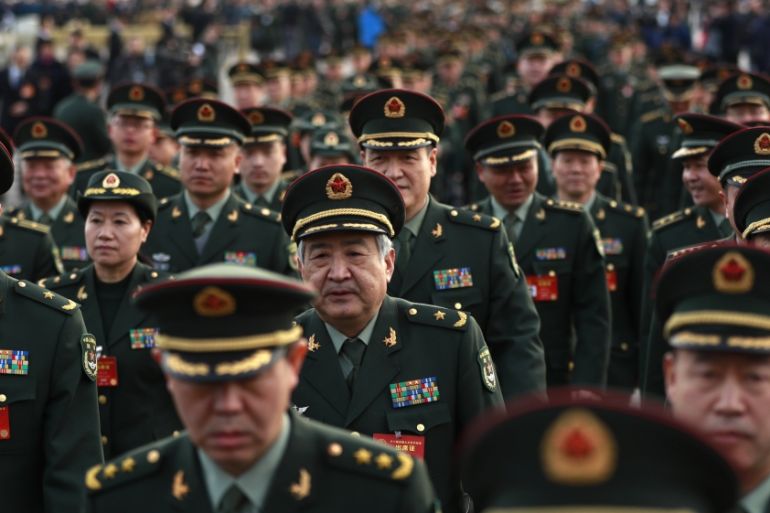Can China afford to challenge the United States?
Trump calls China’s bluff on a naval arms race in the South China Sea.

As China’s parliament, the National People’s Congress, meets this week in Beijing, one problem is on everyone’s mind: China’s surging levels of government and private sector debt.
For the past two years, China has been floating its economy on a massive wave of deficit spending. State-owned firms, state-owned banks, local governments, and the central government itself have pulled out all the stops to maintain China’s official target of 6.5 percent minimum annual gross domestic product (GDP) growth.
Keep reading
list of 4 itemsSeven jurors seated on the second day of Trump’s New York hush-money trial
Six takeaways from first day of Trump’s New York hush money criminal trial
Day 1 of Donald Trump’s first criminal trial
This week the National People’s Congress, or NPC, is widely expected to endorse a slightly lower growth target because of concerns that government debt is spiralling out of control. Like all countries, China faces two options when it comes to controlling deficits: raise taxes or cut spending. With perhaps as many as 100 billionaires sitting as members of the NPC, spending cuts are the likely outcome.
One area where China is eyeing major cuts is defence. Throughout the early 2000s, China’s defence spending grew by double-digit percentages each year. Security experts once expected a whopping 20 percent increase for 2016. The reality was a slowdown to 7.6 percent growth in 2016, followed by a recently announced seven percent growth target for 2017.
These figures are not adjusted for inflation. That means that in real terms, China’s defence spending growth is in line with or slightly below GDP growth. Pressure on the defence budget is an inevitable consequence of China’s slower growth and ageing population. As more and more people reach old age, China’s budget priorities are shifting towards social services.
Western defence analysts continue to warn of a future 500-ship Chinese navy dominating the world’s oceans – or at least the Pacific – but China can ill-afford a naval arms race. Can the United States afford one? Trump seems determined to find out.
Trump’s 12-carrier Navy
With a national debt of nearly $20 trillion and an annual budget deficit approaching $600bn, the US is no stranger to deficit spending. But with real interest rates on federal government debt hovering around 0.5 percent, the US government can and does spend whatever it wants. The status of the US dollar as the world’s reserve currency gives it even greater flexibility.
President Donald Trump may be new to the office but defence is one of the few areas where he has provided concrete details about his spending plans. Trump has proposed a massive $54bn annual increase in defence spending, which would push the total up from $585bn to well over $600bn. The US is already the world’s largest spender on defence – by far. Trump’s proposals would widen the lead substantially.
China should be wary of entering into a Soviet-style spending war with the US that it cannot win.
Much of Trump’s increased spending would go to increase the size of the Navy to 350 major combat ships, up from the current 272. He wants to expand the fleet to include 12 aircraft carrier task forces. The Navy currently boasts 10 operational aircraft carriers with an 11th, the USS Gerald R Ford, to be commissioned in April.
Any comparison of the $13bn Gerald Ford to China’s lone aircraft carrier, the Liaoning, is meaningless. The Gerald Ford and its accompanying carrier task force will be most powerful naval force ever built. The Liaoning is a Soviet surplus vessel that China bought from Ukraine for $20m in 1998, then spent 16 years refitting before it could go to sea.
China’s second aircraft carrier, the Shandong, is now being built with an expected launch date in 2019 or 2020. It seems to be based on the same 20-year-old Soviet design as the Liaoning. China has a long way to go – and a lot of money to spend – before it begins to approach the technological sophistication of the US Navy.
Show me the money
And money is the issue. It is not just US military spending that China can’t match. It cannot match any of its spending. And in the high-stakes world of global power projection, money is everything.
For example, China spends roughly $7bn a year on foreign affairs. The US spends more than $47bn. Trump has been criticised for wanting to cut the Department of State to fund the military, but even a scaled-back state department would be by far the world’s largest, just like the US military.
Ronald Reagan defeated the Soviet Union by spending it into oblivion. Early in Reagan’s presidency, the US budget deficit peaked at 5.7 percent of GDP. That debt had to be financed at interest rates of more than 10 percent. With a budget deficit of 3.2 percent of GDP, real interest rates of 0.5 percent, and a much healthier economy, Trump can much more easily outspend China.
OPINION: Beijing looks for edges on cooperation with Trump
China should be wary of entering into a Soviet-style spending war with the US that it cannot win. If Chinese naval construction provokes Japan into higher defence spending as well, that would only compound China’s problems.
With a rapidly ageing population, catastrophic air pollution, and declining state industries, China’s leaders have enough on their agenda already. War with the US, even if it’s only a spending war, is surely the last thing they need.
Salvatore Babones is a comparative sociologist at the University of Sydney. He is a specialist in global economic structure.
The views expressed in this article are the author’s own and do not necessarily reflect Al Jazeera’s editorial policy.
